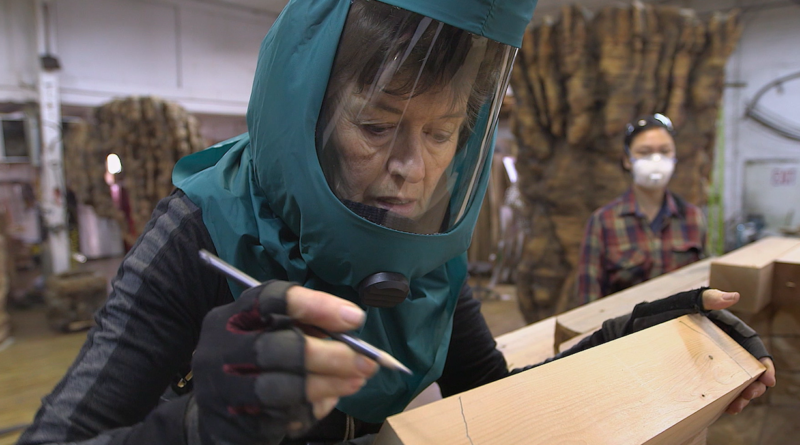INTERVIEW: Sculpting the artistic process of Ursula Von Rydingsvard
Photo: Ursula Von Rydingsvard is the subject of a new documentary from director Daniel Traub. Photo courtesy of Icars Films / Provided by EG PR with permission.
The new documentary Ursula Von Rydingsvard: Into Her Own, by director Daniel Traub, is an intimate portrait of gargantuan dimensions. Audience members are able to learn about the artistic process of this important sculptor while at the same jumping from the micro to the macro and appreciating Von Rydingsvard’s monumental pieces.
For those who haven’t marveled in the shadows of a Von Rydingsvard piece, here’s some background information. The celebrated sculptor has seen her work collected by many major museums, colleges and sculpture parks. She has presented at the Venice Biennale (the place where Traub and Von Rydingsvard first collaborated), and several public places, including New York City’s Battery Park and Barclays Center, have welcomed her tremendous work for outdoors display.
Von Rydingsvard was born in Poland during World War II, according to press notes, and eventually raised in a displaced persons camp. She joined her family as refugees and emigrated to the United States. The sculptor has been living in New York City, her artistic home, since the 1970s.
“She actually originally saw another short film that I made called Xu Bing: Phoenix,” Traub said in a recent phone interview. “And at the time, she was working with the Yorkshire Sculpture [Park] to put out an installation for the Venice Biennale in 2015, so she actually suggested to Yorkshire to commission me to make a short film documenting the installation of her work in Venice. And that was really my first exposure to her work in-depth.”
Before that initial collaboration, Traub knew Von Rydingsvard’s work as a resident of New York City himself. While photographing the city and visiting its many iconic locations he would sometimes run into a Von Rydingsvard sculpture.
“It was about a 10-minute film, and then when I finished that, I became very fascinated by her work,” he said. “My own studio was about a 10-minute walk from her studio in Bushwick, Brooklyn. I started to talk to her and get to know her. We both concluded that there might be the possibility of a longer collaboration between us, so that’s kind of how it started.”
Traub, who has documented other artists on film, believes that Von Rydingsvard appreciated the tone and mood of his earlier work, and that’s what attracted her to this new documentary project.
“I think she probably intuited that we might be good and relate well to each other and might have some similar sensibilities,” the filmmaker said. “I think she didn’t know for sure, and she wanted to test it out by having the Yorkshire Garden commission me to make a short film to begin with, but through making that film we both found that there was a commonality and the possibility of working together. I’ll say that once we did get started, the process took quite a few years. It was at first just still getting to know each other. It took years really before we really got to the point of really trusting each other, or her trusting me more specifically, for the film to become as personal as it did.”
Traub’s initial intention with the documentary was to follow Von Rydingsvard’s process in her New York City studio, so the filmmaker began documenting the sculptor’s work on a new commission for Princeton University. However, as the camera started recording, he realized the portrait needed to be expanded.
“It became clear what the film was calling for was a broader biography of her process, not just that one project, so as the film expanded to other projects, I started to feel like I needed to talk to some other people to get their perspective and bring her in context in the art world and also her history as a person,” he said. “I spoke to curators, to art professionals, but also her family members and close friends to get a broad range of voices.”
One specific challenge to filming Ursula Von Rydingsvard: Into Her Own was Traub’s need to present three-dimensional sculpture in a two-dimensional medium. Both the filmmaker and his subject were aware of these limitations, but they tried to work around them.
“At one point, in the film, she actually says that you can’t really see her work in two-dimensions,” Traub said. “You have to really be there in person, so it was something that I thought about whenever I was filming her. I think the way I tried to get around that was to show her process as viscerally as I could, really getting as close as possible, getting the sound and trying to get a sense of the texture through people touching the work. So I think I was trying to make it very sensual, as much as can be done through film, using sight and sound and all the other senses … to make up for not being able to be present directly.”
Critics and audience members agree that Ursula Von Rydingsvard: Into Her Own, now available on VOD and DVD, intimately and monumentally captures the sculptor’s work, life and impact.
By John Soltes / Publisher / John@HollywoodSoapbox.com
Ursula Von Rydingsvard: Into Her Own, directed by Daniel Traub, is now available on VOD and DVD. Click here for more information.

